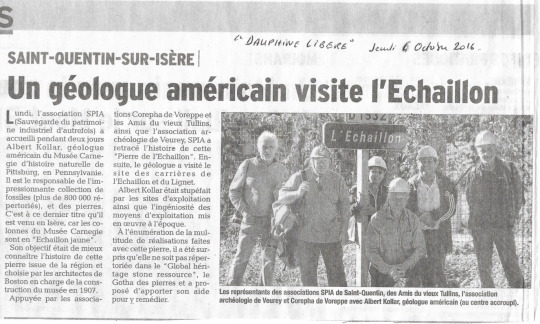
Last month, Carnegie Museum of Natural History Geologist Albert Kollar was traveling in France on a research trip, where a local newspaper wrote about his work. Read the translation below.
In the picture, Kollar is photographed with representatives of the SPIA associations of Saint-Quentin, the Friends of the old Tullins, the Archaeological Association of Veurey and Corepha de Vorepp. Kollar is in the middle, crouching.
An American geologist visits the Echaillon
Saint-Quentin-sur-IsèreOn Monday, the association SPIA (protection of the past
industrial patrimony) welcomed for two days Albert Kollar, an American
geologist from the Carnegie Museum of Natural History in Pittsburgh, Pennsylvania.
He is the person responsible of the impressive fossil collection (more than
800.000 registered) and the stones. It is in this regard that he came in Isère,
because the columns of the Carnegie Museum are made of “yellow Echaillon”.His objective was to know better the story of this stone
stemming from the region and chosen by the architects of Boston in charge of
the construction of the Museum in 1907.Supported by the associations “Corepha de Voreppe” and “The
Friends of the old Tullins”, and by the Archaeological Association of Veurey,
SPIA reconstituted the story of this “stone of Echaillon”. Then, the American
geologist visited the stone quarries of the Echaillon and the Lignet.Albert Kollar was amazed by the production sites and by the
ingenuity of the techniques used by the past.Despite the multitude of constructions made with this stone,
he was surprised that it was never recorded in the “Global heritage stone resource”,
the Gotha of stones and proposed to provide assistance to remedy it.
